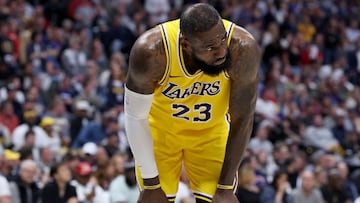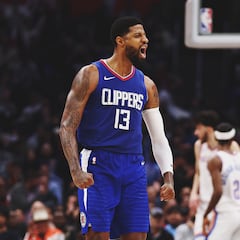The NBA salary cap explained: cap exceptions, veteran salaries, max contracts...
Find all the information on the 2024-2025 NBA salary cap: trades and players’ roles, contract extensions, and the 11 types of salary cap exceptions.

The NBA salary cap, which is the ceiling that sets a limit on how much teams can spend on their players during a season, is the only one in the American League that is somewhat workable. The NBA has a “soft cap” that allows teams to exceed the cap limit. Sometimes, franchises can go over the cap limit and the luxury-tax line, simply paying the penalty for what they exceed. The Warriors and the Nets are good examples of teams have have dived into tax with nine-figure bills during recent seasons.
When a team blows past its cap room, they have a series of exceptions that allow them to exceed that cap, including mid-level, bi-annual, and several forms of Bird rights that you will read more of below.
You might also enjoy
Once a team uses any of these roster scenarios, they become hard-capped, and cannot surpass the given “tax apron” at any point during the rest of the league year; the first apron for the 2024-5 season has been set at approximately $178.7 million - up from $167 million last year.
Once the league year ends and the new one starts, hard-capped teams become free again to exceed the succeeding year’s tax apron; an apron is essentially a hard cap for any team that acquires a player via sign-and-trade, signs a player using the non-taxpayer mid-level exception, or a bi-annual exception.
NBA Minimum Veteran Salaries
Unless an NBA team is up to its hard cap, they should be able to sign a player to a minimum-salary contract if they are both out of cap space and have used their mid-level or bi-annual exceptions. Unlike the mid-level or bi-annual exception, a minimum salary exception can be utilized several times, allowing teams to add as many players as the roster limits.
The players often receiving minimum-salary contracts are undrafted free agents and second-round picks. But several veterans settle for the minimum.
D'Angelo Russell with the big-time shot 🫡 pic.twitter.com/d70AD92Lcf
— Los Angeles Lakers (@Lakers) October 31, 2023
Since an NBA player’s minimum salary depends on his experience, veterans often earn salaries twice as much as rookies on minimum-salary contracts.
The NBA reimburses clubs that sign veterans with three or more years of experience to one-year minimum salary contracts to prevent teams from always choosing younger and cheaper players over veterans. These deals also count against a team’s cap and bank balance. The minimum salary for a player with two years of experience in the NBA is $1,836,090.
11 types of Salary Cap exceptions in the NBA
Qualifying Veteran Free Agent Exception (“Bird” Exception): If a free agent has played for a team for some or all of three consecutive seasons, they may re-sign him to a contract with a first-year salary of the maximum player salary.
Early Qualifying Veteran Free Agent Exception (“Early Bird”): The Early Bird Exception is used to sign a contract for at least two seasons. If a free agent has played for a team for some or all of the two previous seasons, a team is allowed to re-sign him with a first-year salary of up to 175% of the player’s salary of his last season’s contract or 105% of the average wage for the previous season,
Non-Qualifying Veteran Free Agent Exception (“Non-Bird”): A free agent who’s neither a “Bird” nor an “Early Bird” player may re-sign a contract with a first-year salary of 120% of the player’s salary in his previous season’s contract, or 120% of the player’s minimum salary for the given season, or lastly if the player is a Restricted Free Agent, his Qualifying Offer amount.
Steve Kerr acknowledged his two-year contract extension was in part to line his contract up with Steph Curry’s: “Let’s keep it rolling for another couple years and then reassess at that point.” pic.twitter.com/oZToL2JRnZ
— Anthony Slater (@anthonyVslater) February 27, 2024
Bi-annual Exception: Teams who want to sign one or more players to contracts whose first-year salaries are up to $3.382 million can use this exception, and teams who want to re-sign their free agents and not acquire a player by assignment. Signed contracts, however, cannot cover more than two seasons or be used in succeeding years.
Non-Taxpayer Mid-Level Salary Exception: teams who want to sign one or more players to contracts whose first-year salaries provide for up to $8.641 million, as well as re-sign their free agents and not acquire a player by assignment. This exception can be used for up to four NBA seasons.
Taxpayer Mid-Level Salary Exception: teams who want to sign one or more players to contracts whose first-year salaries provide for up to $5.337 million re-sign their free agents and do not acquire a player by assignment. This exception can be used for up to three NBA seasons.
Mid-Level Salary Exception for Room Teams: this exception applies if teams haven’t used any of the Bi-annual Exceptions, the Non-Taxpayer Mid-Level Salary, or the Taxpayer Mid-Level Salary Exceptions in the same Salary Cap Year. Similarly, teams using this exception can sign one or more players to contracts whose first-year salaries provide up to $4.449 million, re-sign their free agents, and not acquire a player by assignment. This exception can be used for up to two NBA seasons.
Rookie Exception: Each season before the Moratorium Period starts, a new Rookie Salary Scale reflects the Salary Cap from the previous year. Teams can sign their heir first-round draft pick for up to 120% of his Rookie Salary Scale amount.
This year, the Free Agency moratorium period begins on Sunday 30 June at 6 p.m. EDT. when teams can negotiate deals with free agents, but players aren’t allowed to sign their new deals officially until after 12:01 p.m. on Saturday 6 July.
The Golden State Warriors and franchise icon Klay Thompson reportedly are prepared to part ways during free agency. The four-time NBA champion is already being tied to a few potential suitors. https://t.co/k0Ugrn4EZG
— San Francisco Chronicle (@sfchronicle) June 30, 2024
Minimum Salary Exception: This exception can be used to acquire a player with a signed minimum contract of one or two years by assignment. Teams can sign the player to a one or two-year contract at the minimum player salary.
Disabled Player Exception: When a player suffers an illness or season-ending injury, teams can replace him with one player to a contract’s salary of either 50% of the disabled player’s current salary OR the season’s amount of the Non-Taxpayer Mid-Level Salary Exception.
Traded Player Exception: A year after the trade of a player’s contract to another team, that player can be replaced with one or more acquired players by assignment. This exception pertains to non-simultaneous and simultaneous trade rules, which are complicated even to NBA experts. Find the full NBA contract Exception rules here.
How do NBA trades work?
In the NBA, players are traded for various reasons, the most common being team improvement and money saving. A trade exception allows teams to sell players as long as their incoming salary does not surpass a specific amount; this amount is determined based on the outbound salary and whether the team pays the luxury tax after any trade. Teams that trade players with a higher salary than the one they earned can use the trade exception.
An additional trade rule is a “Sign and Trade” deal. Just like it sounds, this deal allows a team to ‘sign’ its player to a new contract and then include him in a ‘trade,’ which gives the acquired team the right to own that player’s Bird right. As you have read above, this type of contract enables teams to re-sign a player as soon as his contract expires, even if they are over the cap.
MALIK MONK SLAM 😱 pic.twitter.com/dkwKjyqlog
— Bleacher Report (@BleacherReport) December 23, 2023
Teams can re-sign with their free agents and trade them to another club 48 hours later. They can also sell players they acquired immediately in what is known as a one-on-one deal. Moreover, only unrestricted free agents, players with expired contracts, can get involved and sign with any team. Unlike this exception, restricted free agents have permission to explore the market, but their restriction comes with their original teams being authorized to match any offer other teams provide.
Teams cannot take on an unlimited salary and pull off trades as they like, which is why salary caps exist.
In addition to the complicated rules of trades in the NBA, it’s worth noting that there is no limit to how many times a player can be traded in the NBA.
Do NBA players get a say in trades?
The excellent news, NBA players have a say in when and where they get traded. Of course, there is a difference between superstars and other players when it comes to asking for trades, but still, they all have more control than ever before; players like the Nets’ Kyrie Irving have the luxury to decide where he gets traded.
This steadiness between players and teams exists now because of the abundance of money and salary cap flexibility.
A year ago, Jaylen Brown signed the largest contract in NBA history and was asked how he planned to use it.
— Front Office Sports (@FOS) June 18, 2024
His response was all about giving back to Boston and attacking the wealth gap in his community.pic.twitter.com/aIai50o3uS
NBA Contract Extensions
So far, some of the most profitable contracts signed in the 21-22 league year were contract extensions, not free agents.
Contract extensions are exactly how they sound; they enable a team to lock a current player (or players) for a few years. Extensions have a significant role in impacting the team’s salary cap situation for various seasons.
The most common contract extension in the NBA is the Rookie scale Extension; in the 2020 season, there were ten rookie scale extensions. Former first-round picks going into the fourth and final year of their rookie deals have the right to sign those up until 21 October. Four to five players are the common ones we see signing up for rookie scale extensions.
Related stories
Veteran Extensions have become more common since the CBA, or the Collective Bargaining Agreement, has added incentives and widened eligibility rules for stars to sign deals before reaching free agency. There have been numerous veteran extensions in the previous league years.
A player on an expiring deal can sign a new contract under the veteran extension anytime during the season. However, a player who isn’t going into the final year of his current contract has until Sunday 21 October 2024 to sign for a veteran extension.

